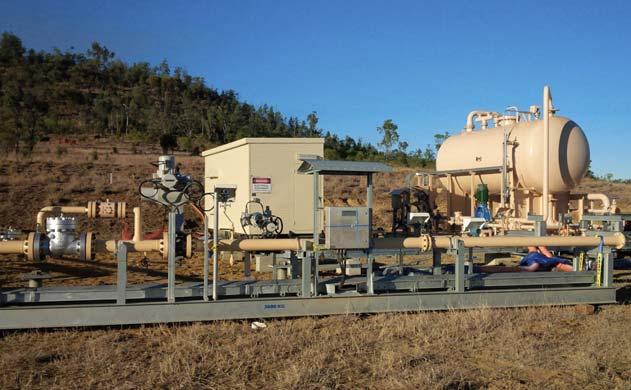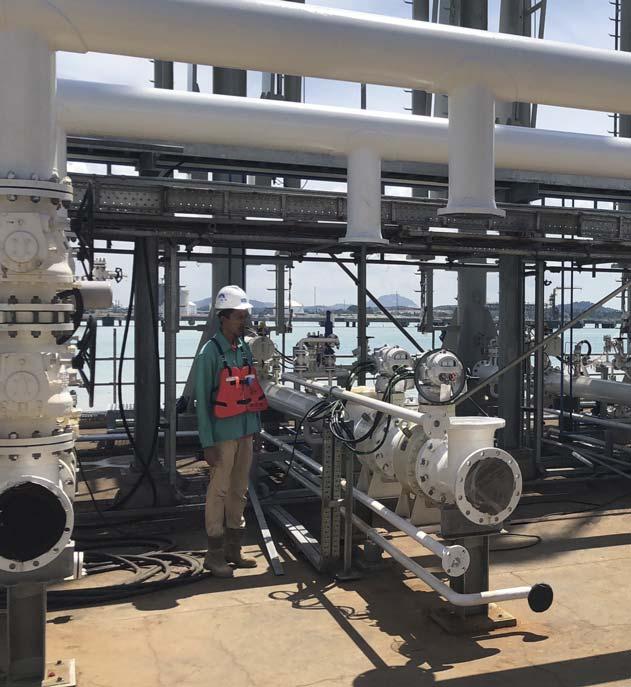
7 minute read
Keeping a steady fl ow
Figure 1. Flow control systems play a role at all stages of the journey of LNG.
Figure 2. Rotork actuator installation at a wellhead and separator skid in Australia.

Extremely cold temperatures are an inherent part of LNG. During the liquefaction process, the natural gas is cooled to -162°C, when it becomes the clear, colourless liquid that is known as LNG. The valves used to control the fl ow of this product must therefore be suitable to work at very low temperatures. For example, cryogenically safe valves are primarily made from 316 stainless steel, which maintains body strength at these very low temperatures, and they must meet safety standards such as BS 6364. The fl ow control equipment that controls the valves, such as actuators, must also provide safe and reliable operation within consistently hazardous environments. Products must allow for maximum uptime and operational effi ciency. Flow control systems that have been well designed and correctly maintained will allow for this, as well as compliance with environmental standards.
The precision and control provided by actuators removes human error, increasing accuracy, effi ciency and reliability within an automated process. For example, intelligent electric actuators, such as IQ actuators from Rotork, play a vital part in the transportation of LNG, controlling the fl ow of liquefi ed gas onto carriers in a safe, reliable and effi cient fashion. Intelligent actuators have many other benefi ts in controlling the fl ow of LNG, such as detailed real-time and historical feedback information through data logs (e.g. alarms, valve torque profi les and number of valve movements/operations). They will be suitable for use in hazardous environments; actuators within the IQ range are explosion-proof, offer double sealed enclosures to prevent water ingress and are IP rated (IP66/68 at 20 m for 10 days).
Flow control in LNG downstream applications
Regasifi cation usually occurs at a coastal import terminal. These terminals have specialised requirements to cater for the management and handling of LNG. The performance of actuators is a key part of safe and reliable operation during these processes and the fl ow control products used require high safety standards. Actuators are a constant presence at automated tanks farms, performing isolating duties for routine fl ow control, modulating actions and fail-safe activity for vital safety requirements. Tank farms will also use intelligent electric actuators for safety related duties such as emergency shut down (ESD), which is vital in case of dangerous events such as fi re, fl ooding or any event where continued operation could be hazardous.
Pneumatic fl ow control equipment is another common sight on LNG terminals and sites. Pneumatic scotch yoke actuators, such as Rotork’s GP range of pneumatic actuators, operate the cryogenic valves used on main pipelines. They perform open/close functions, controlling the natural gas before and after it is made into LNG, as well as the LNG itself. The precise control that these actuators offer is essential. For example, fl ow can be cut off straight away by the fail-safe functionality before any damage is caused due to the spring-return module inside the actuator. Some valves within vaporisers are small and compactly arranged, requiring compact and quick actuators that offer isolating and modulating duties in hazardous and cryogenic environments. The applications at this stage of the LNG process include tank pump discharge, vapour discharge, tank liquid fi ll, water cooling circuit valves and operation of gas outlet valves.
Control and monitoring centres also play a key role on LNG sites, controlling hundreds of actuators simultaneously. Rotork’s ‘Master Station’ control system, for example, is in use across the world on LNG sites such as the Pengerang deepwater petroleum terminal in Malaysia, which has a regasifi cation unit, two 200 000 m3 LNG storage tanks, and berths for the loading and unloading of LNG vessels. While the actuators control the fl ow of LNG, a master station remotely controls the hundreds of intelligent actuators, using a fi eld network (PakscanTM). This kind of system provides robust and reliable plant control and monitoring, which is essential within the LNG industry.
The importance of intelligent flow control asset maintenance
Intelligent fl ow control assets within the LNG industry maximise operational reliability and effi ciency. This article has focused on the importance of these assets within the LNG industry, but their maintenance and smooth running is of equal importance. LNG fl ow control assets perform daily in challenging operating and environmental conditions. They often work within environments with extreme temperatures and excess vibration, yet still need to operate reliably. Maintenance programmes that support assets in working effectively (ensuring the availability of assets at all parts of the LNG journey) are essential. Asset failure or obsolescence has dangerous implications, including reduced quality, fi nancial loss and even reputation damage. Unplanned downtime is undesirable and costly, but sites which have a full life cycle asset management programme (such as Rotork’s ‘Lifetime

Figure 3. IQ3 actuators at the Pengerang terminal, Malaysia, during the installation stage.
Management’ programme) are likely to see improved performance, increased uptime and an important decrease in unplanned maintenance costs. These service programmes offer a steady, set cost to plant operators. A service plan for fl ow control assets all along the LNG journey should have a holistic view of an asset’s life cycle, with fl exibility and customer choice, allowing customers a bespoke approach to maintenance.
In addition to bespoke maintenance programmes, many fl ow control products must have Safety Integrity Level (SIL) ratings. SIL is an established system of standards of the performance requirements of a safety system. It is part of an overall shared safety plan that includes techniques, technologies, standards and procedures that help operators protect against hazards, an essential function within LNG.
Conclusion
The current demand for LNG has many explanations, including the multitude of ways in which it can be used (both domestically and industrially), a clean burn and subsequent reduction in combustion relayed emissions (compared to other fossil fuel sources), and the advances in technology within the natural gas industry which mean more is now being found. The ability to liquefy and then regasify this gas means it can be accessed by countries in every corner of the world. The LNG industry is complex, but with effi cient and reliable fl ow control equipment such as actuators, LNG production, transportation and distribution can be conducted in a safe, productive and profi table way. Effective fl ow control and associated systems play a vital role at all stages of the LNG journey, meeting the ever-growing increase in demand.
Reference
1. ‘Global gas and LNG market outlook to 2035’, McKinsey.
Need a reprint?


We can tailor to your requirements, produce 1 - 12 page formats, print colour or mono and more


Tony Dodd, Servomex, UK, explains how to improve operational excellence through digitalisation of gas analysis equipment.


Reliable, accurate and stable gas measurements are essential to many industrial operations, helping to optimise production processes, maintain safety and meet regulatory requirements. As current innovations in technology and digitalisation develop, it is almost certain that the solution surrounding the measurement can be improved, with signifi cant benefi ts for the operational excellence of plant operators investing in Industry 4.0. The challenges introduced by cultural and workforce shifts have combined with ongoing economic, competitive, and regulatory pressures to increase the focus on operational excellence – seeking the optimisation of processes, assets and people.
Operators performing in the top quartile stand out when compared to competitors in the fi elds of safety, reliability, effi ciency, sustainability and fi nancial performance. On average, they record three times fewer safety incidents, see a 4% increase in operational availability, reduce maintenance costs by half, lower emissions and energy use by 30%, and reduce operating costs by 20%.
The positive impacts on profi ts and margins make a continued focus on operational excellence critical to













